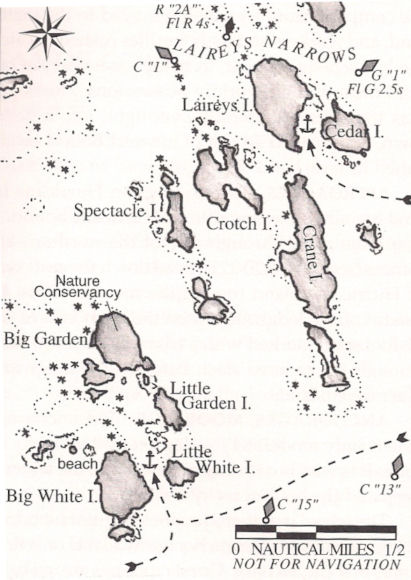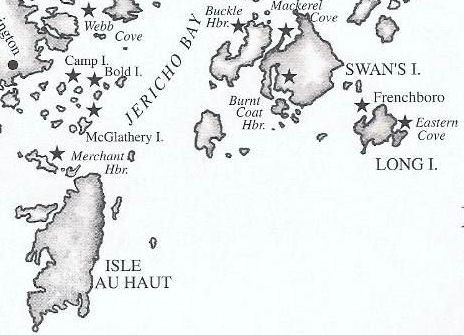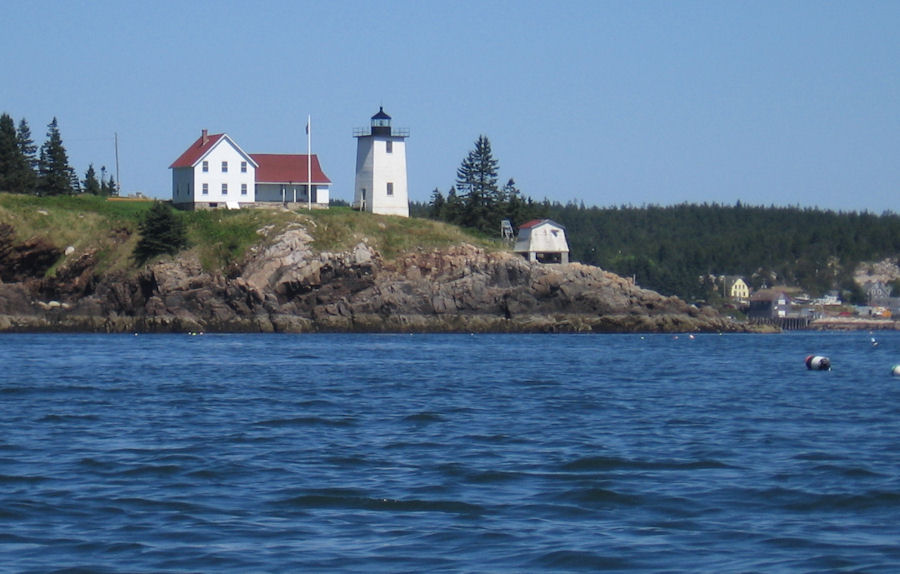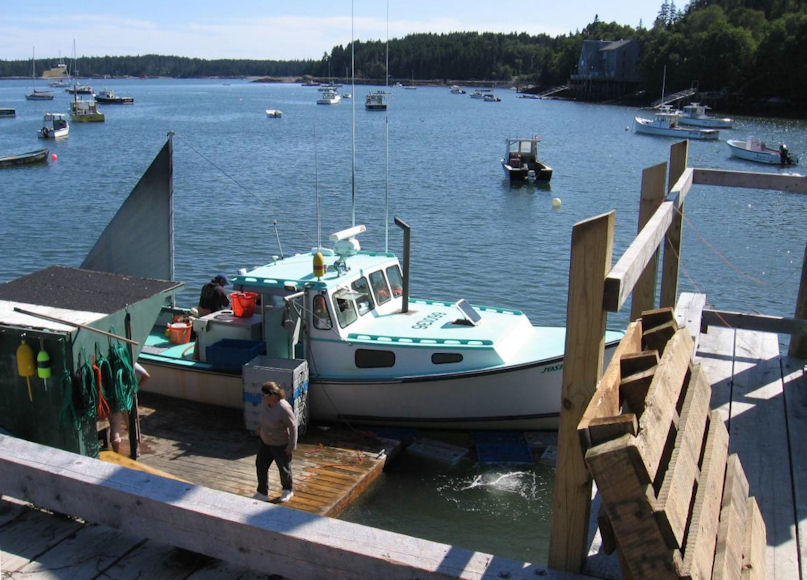| Danny Clears the Way for a Great
Maine Cruise by Dick Harrington Part I ... |
||
| Saturday,
Aug 29, 2009. “GALE
WARNING IN EFFECT 8 AM EDT THIS MORNING
THROUGH SUNDAY MORNING. E. winds 15 to
25 KT.….increasing to 20 to 30 KT. Seas
4 to 7 ft….building to 6 to 8 ft. this afternoon. Showers. Widespread fog. Vsby
1 to 3
NM. Tonight NE winds 25 to 30 KT. Seas 7 to 10 ft.” Friday,
Aug 28. Having left
Geneva, Ohio, shortly after 9:00 AM with Blue Mist in tow, Dennis and I
arrived at Camden Hills S.P. campground on the central part of
the Maine coast after midnight. The trip of 750 miles or so was
uneventful and for the last several hours the roads very quiet, but we
were ready for sleep. To our surprise, the campground had rolled
up the carpet and closed the gate hours earlier. We were forced to
‘break-in’- no lock, just a pin inserted into the arms of the
gate. I would apologize in the morning. We had arrived on
the shores of Penobscot Bay, our home waters for the
next nine days.
A frequent Maine visitor, I have - over the past 15 years - cruised most of Maine’s rocky mid-coast region. My ‘bible’ for cruising Maine, A Cruising Guide to the Maine Coast by Hank and Jan Taft/Curtis Rindlaub. My 16-foot wooden Wayfarer was built in England in 1964. The Wayfarer, designed by Englishman Ian Proctor in 1957, is one of the world’s outstanding cruising dinghies. Dennis Figley, also a Wayfarer sailor, lives in Ashland, Ohio. This would be his first time in Maine waters. For several days, the two of us had been following Hurricane Danny’s progression up the east coast. Though barely obtaining category I status, and now down graded to a tropical storm, Danny was making me nervous. I’m sure Dennis was affected, too. I had my fingers crossed, hoping we might receive just a glancing blow. Shortly after we turned in, light rain started to gently patter on the tent, and we began to hear wind in the tree tops. |
||
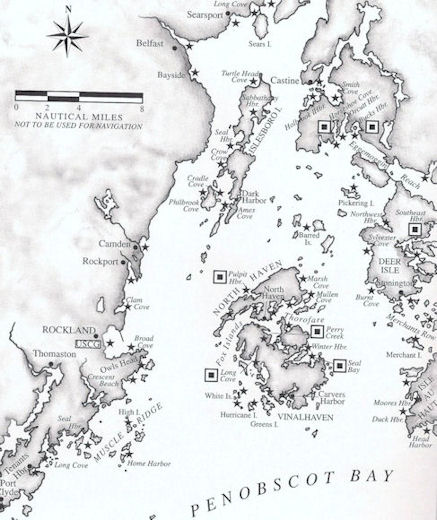 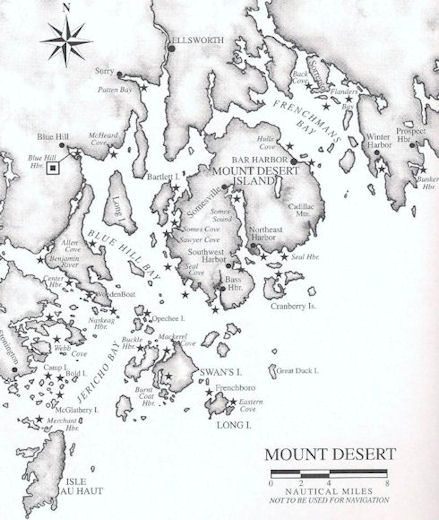 for larger-size chart, click here - joins Mount Desert to the
east joins Penobscot Bay to the
west - for larger-size chart, click here
(from ‘Taft’)
. |
||
|
Saturday,
Aug 29. By morning, a steady soaking rain was driving down, the
air was bone chilling, and wetness was invading the tent. A
weather radio check confirmed the expected: we stood no chance of
launching this day. So we decided to keep the tent site for
another day and check out the area by auto. I would take Dennis
on a tour of the region, hitting a few of my favorite places.
Meanwhile, we planned to get an early start Sunday.
Following breakfast in normally bustling Camden, but which was soggy and subdued this day, we headed down to Rockland Harbor—except first, I had to stop along the way at the Rockport Marine boat shop. It being a Saturday, the shop was still. However, we were thrilled to be allowed to explore the insides of this large renowned wooden boat shop. There were three magnificent restorations underway; it was awesome to just be able to run our hands over some of those massive timbers. Rockland Harbor was awesome too, but in a less fulfilling way. This was where we were planning to launch. A semi-commercial harbor, Rockland is large and rather open, particularly to the east, which was bad this day. The problem with most launch sites in this part of Maine is finding long-term parking. The local communities tend to be exclusive. But at Rockland there is a large public parking area, and the launch ramp is good and well protected. This was where my good friend and fellow Wayfarer cruiser, Tom Graefe from Norwell Mass., departed from on his most recent cruise in 2007. Standing on the harbor wall near the Harbor Master’s house, we were subjected to the full fury of the 30-plus-knot gale-force wind, and rain, straight in the face. Benefiting from a long unobstructed fetch down the harbor, good size white-caped seas were rolling through the anchorage, causing even larger boats to lunge at their moorings like wild ponies. What would Sunday be like? Suddenly, I found myself thinking of other possibilities. Maybe we should consider Round Pond and start out on Muscongus Bay, I suggested to Dennis. Chock full of islands, Muscongus Bay offered a lot of immediate protection if the wind stayed strong. In the past, I as well as Tom Graefe, started some great cruises from picturesque and less known Round Pond, located on Muscongus Sound. The launch ramp there was also excellent and we had been permitted to park in a vacant lot behind the white church, a short walk up from the harbor. Things have changed! The property is being sold and parking is now out. I was in shock. Even with the help of the kind woman managing the small general store, our attempts to find an alternative place to park were unsuccessful. This was a very sad day for me. Round Pond had been a wonderful place from which to start a cruise. But, all was not lost. Back on
Penobscot Bay, at Tenants Harbor, where we enjoyed a great seafood
dinner at the Cods End on the end of the wharf, we managed to woo one
of the waitresses at the Farmers Restaurant into letting us park in her
yard for a small fee. This unexpected stroke of luck put us into
a much happier frame of mind. So finally the launching place was
settled: it would be Tenants Harbor in the morning.
...Back at our tent site the wind blew the tree tops even harder and the rain continued non-stop. The people we talked to during day had offered little encouragement that tomorrow’s weather would let us start our cruise. Oh, well, have another whisky, Dennis! Some time late into the night, the wind and rain abated. |
||
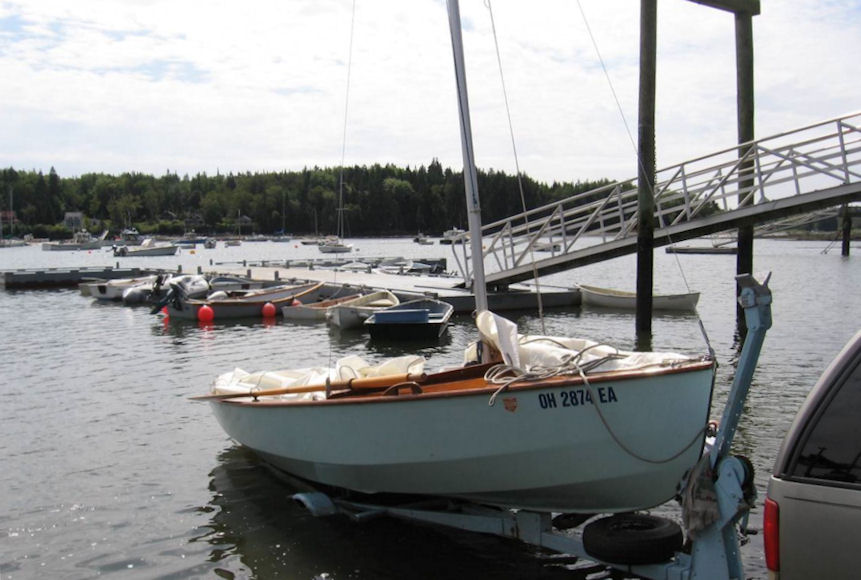 Launching Blue Mist at Sunday, Aug 30. Miraculously, by the time we have packed up and arrived at Tenants Harbor
the sun is
shining and we are looking at a marvelous day and images
of Danny quickly fade away. By
a little past noon, Blue
Mist is fully loaded and ready
to be off.
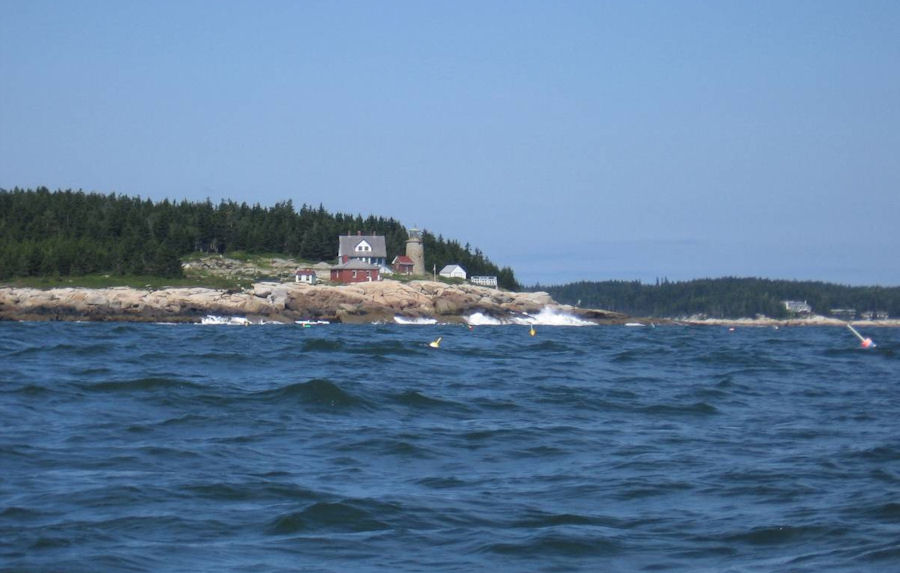 Whitehead Island Light marks the southern approach to Muscle Ridge, a series of north-south islands a mile or so into the bay. Five- to six-foot swells were running due to Danny. 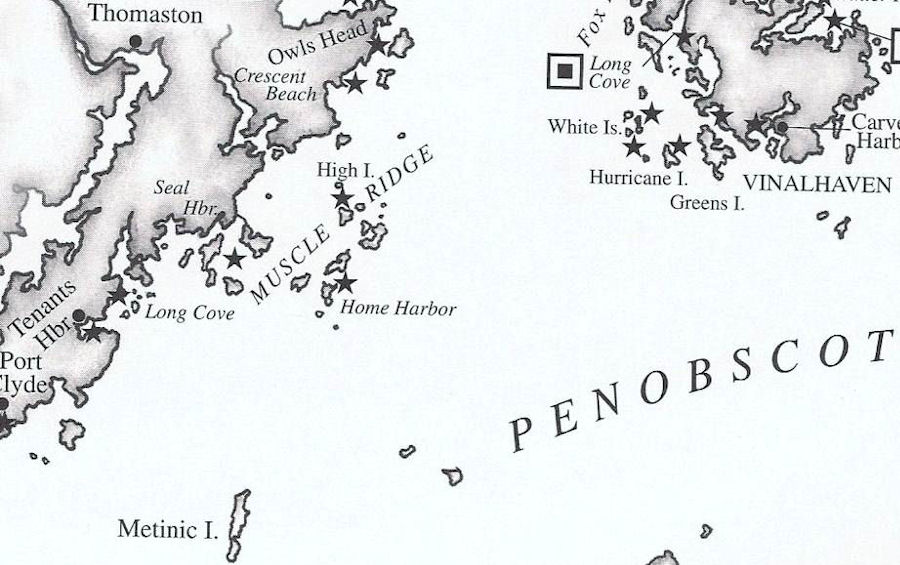 Cresting impressive six-foot swells left
over from Danny, sailing was
perfect fun with 10 to 15 knot southwesterly breeze from behind.
Dennis had Blue Mist on a
northeasterly heading, aiming for the Muscle Ridge Channel. There
is a nice picturesque anchorage at the north end of Muscle Ridge, but
that would mean stopping too soon. So, providing wind and time
hold out, we will continue across the western arm of Penobscot Bay to
the White Islands. Though bucking a bit of a tidal current, we
are making fast progress.
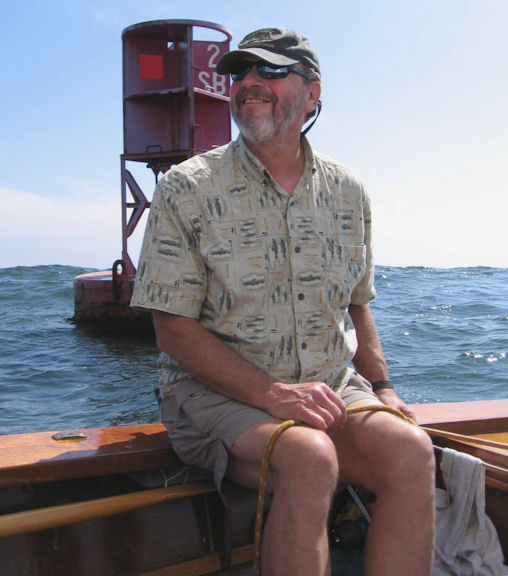 The horizon is blocked out by a big swell - Dennis at the helm. We maintain a sharp
lookout for seals and
porpoises.
There, that dark blob bobbing amongst those brightly painted lobster
trap buoys, is it a seal? Sometimes it is,
and the cute face soon ducks beneath the surface, disappearing behind a
big
swirl. At other times we are fooled by a
trap buoy, darker than usual. Porpoises are
more elusive, but we manage to make one or two sightings while
crossing.
A couple of times in the past I’ve had the
thrill of sighting a whale. But that is
rare and not likely to happen within
Named for the bright reflection of their shining granite shores, visible from many miles out, the White Islands (chart above) are a group of four small islands located on the west side of Vinalhaven Island. Remote, they are a marvelous wildlife sanctuary, devoid of human habitation. Osprey, surely bald eagles as well, reside here, though I have not been lucky enough to spot an eagle. The islands create a small, snug harbor and are one of my favorite anchorages. 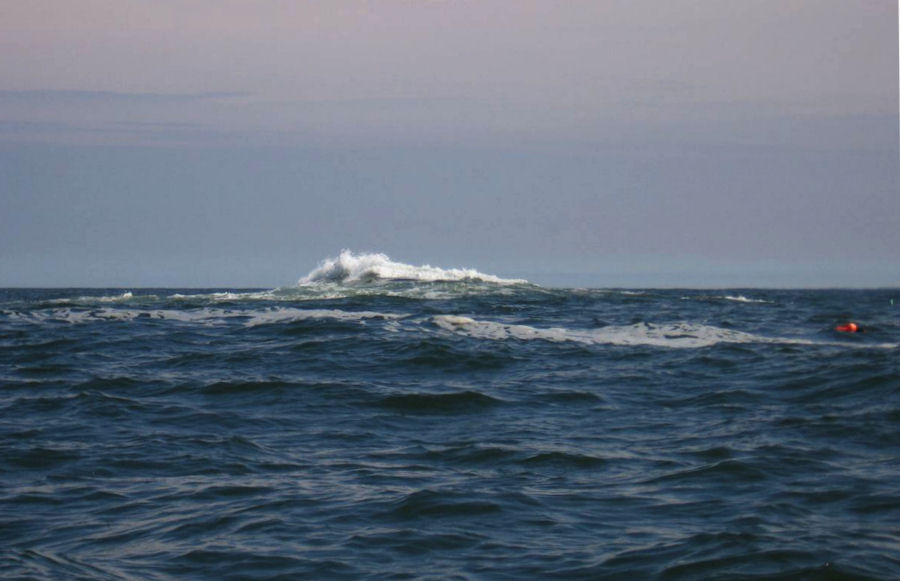 Swells breaking on a shoal - leaving a trail of froth running off to leeward. Because
they are out-lying islands, I was worried that a
surge from
the large ground swell might be rolling within the harbor. Indeed, we
found the narrow entrance tricky,
with waves washing high up the sloping rocks, causing surging.
But once inside and anchored, Blue
Mist rolled
only slightly to a gentle swell. We had enjoyed
a great day of sailing, covering approximately 15 NM
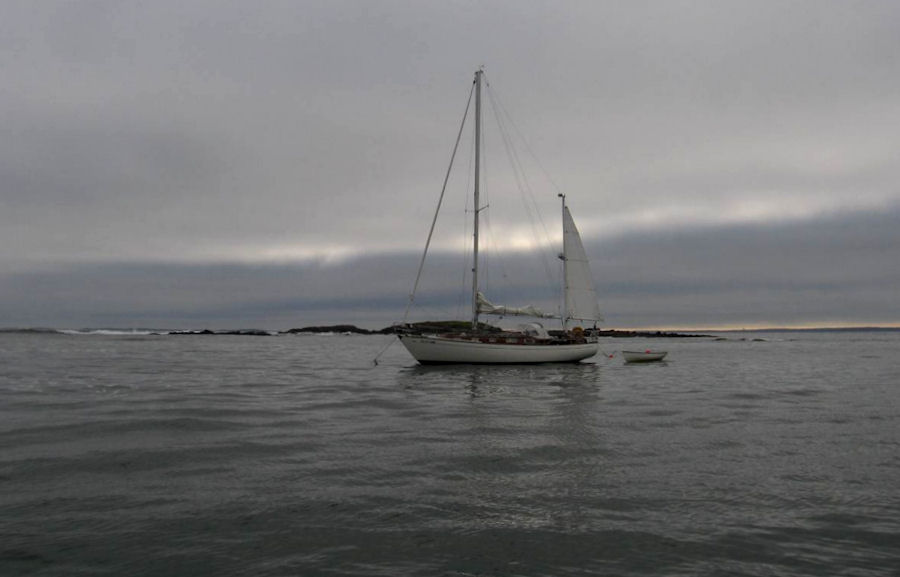 The Rindlaubs’ 35-ft. ketch Indigo - White Islands. Also anchored in this
small harbor was an attractive modest size ketch. All the while
we were relaxing and making dinner (I cooked venison chili!) she showed
no signs of life. However, as dusk was settling, two people
headed out in a dinghy to explore the shore of the nearby island.
Upon their return, we hailed them; I was utterly surprised to learn it
was Curtis Rindlaub and his wife, Carol Cartier. Curtis, who has
taken over editorship of A Cruising
Guide to the Main Coast, is also
the author and publisher of Main
Coast Guide – Casco Bay; a guide
specifically aimed at small boats. Many of our Wayfarer cruising
gang found this guide to be a handy resource at our last Hermit Island
rally.
The Rindlaubs are as surprised as we to run across one another in this manner. Though we have never met, Curtis immediately identified me from Blue Mist. With the two boats’ gunwales nearly touching, the four of us enjoyed a pleasant conversation, with Curtis keenly recalling some of the e-mail exchanges with our gang prior to Hermit Island. No motor on the dinghy, Carol effortlessly rows back to their ketch - fitting, I think, for a guy who enthusiastically encourages small boat cruising. It is only eight o’clock, but darkness has long ago engulfed us and now the air is definitely cooling down. The night-time temperature will be dropping into the fifties. It is time to pull the boom tent back over the transom. With the outside world walled out, the cockpit is transformed into a peaceful, comfortable cabin. Dennis switches on his LED headlamp and begins to read. His book is Stalking the Blue-Eyed Scallop by Euell Gibbons - more about that later. For a while I continue to sit up and just let my mind wander, enjoying a whiskey. Blue Mist rocks ever so gently, with the sea making occasional soft gurgling noises against her hull. Dennis’s head has dropped to his chest, headlamp still shining. Soon, I too am fast asleep; it has been an exhausting day.
|
||
|
Monday, Aug 31. A high pressure system will
dominate
throughout the week, providing the best stretch of pleasant, sunny weather Maine has enjoyed all
summer. We are up and moving by 6:00 AM - amazing for me.
During breakfast, a gentle morning breeze
greets us out of the north. It is a
wonderful day to be on
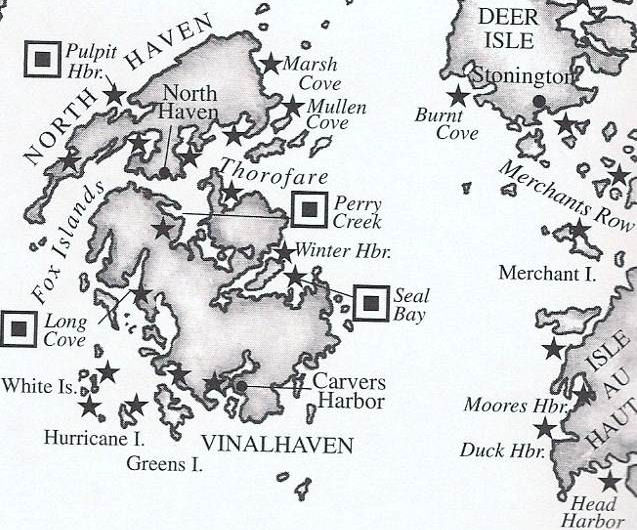 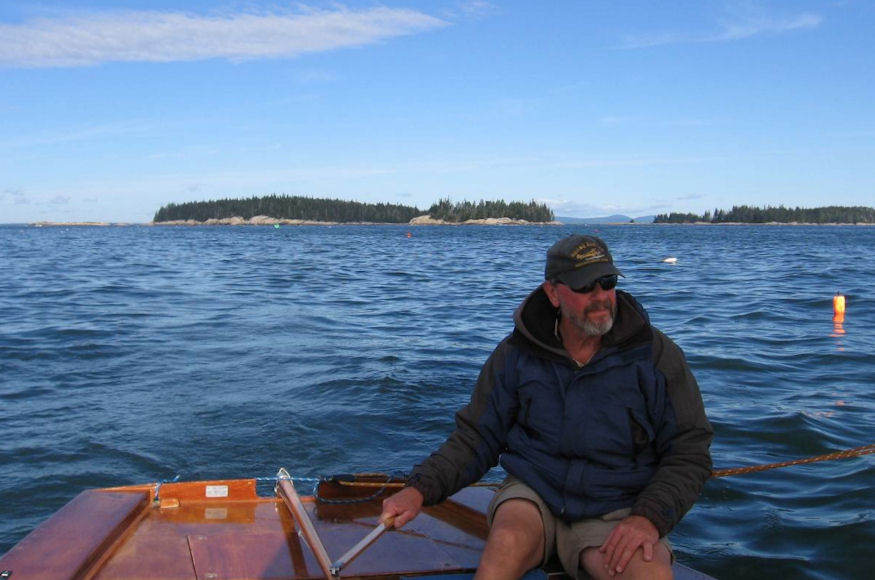 Headed for Arriving at the School we were taken
aback to find none of the famous pulling boats at the moorings, and no
caretakers present at the facility.
Though it appeared that people would soon be back, the school
apparently
had closed for the year.
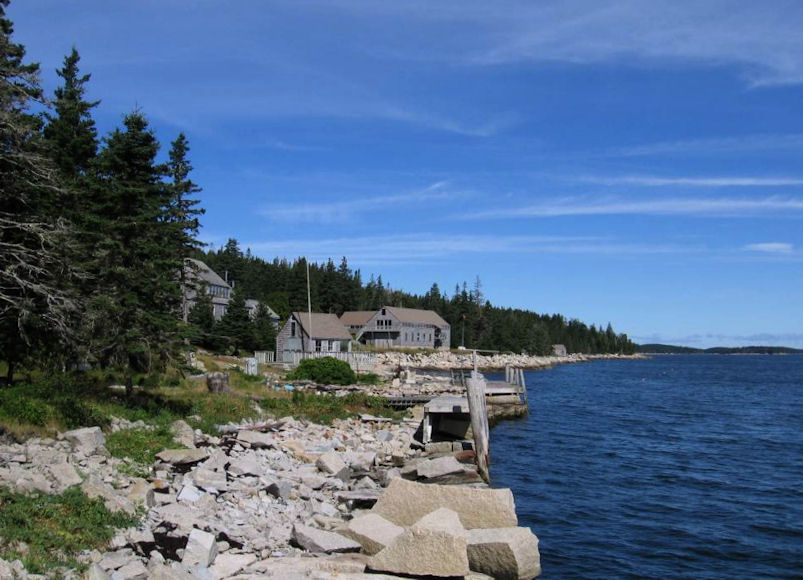 Hurricane Island Outward Bound School was deserted. Our next stop after
Hurricane Island, will be Carvers Harbor to resupply with water.
During the night, my 5-gallon Coleman camping water jug lost most of
its contents into the bilge. I thought that the cap accidently
got turned to ‘open’ - but later we found out it had sustained a
puncture. I vowed to use something smaller in the future.
Five gallons, combined with the various other drinking bottles we were
carrying, is more than necessary. Actually, Blue Mist was a
little overloaded - with more food, water, and clothing than we needed.
Of the many unique experiences Maine offers, to me a visit to one of her true working harbors ranks high. Carvers Harbor is a serious fishing port, and home to some big off-shore fishing vessels. These boats are entirely different from the everyday lobster fishermen. Looking at the gear on the boats in Carvers Harbor, I have little clue to how they fish, or what they catch. But they are impressive. For a Wayfarer, Carvers Harbor is an interesting place to visit, but not to stay. The sail from Hurricane Island to Carvers Harbor again is short. We tie up at the town landing and stay just long enough to buy a couple of 2-1/2 gallon water jugs at the supermarket. 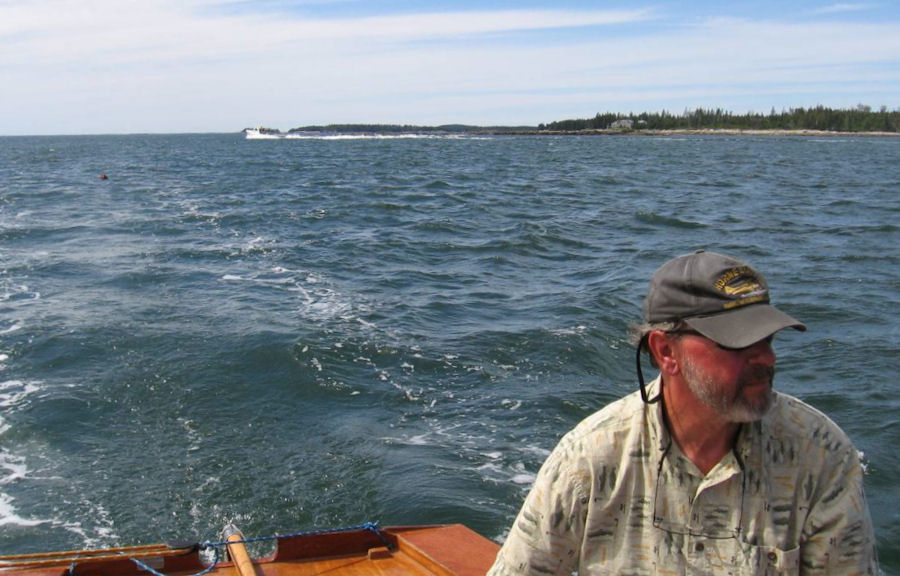 Rapidly leaving Vinalhaven astern, Blue Mist barrels along before a 10 to 12 knot southwesterly, headed for Merchants Row - Dennis at the helm.
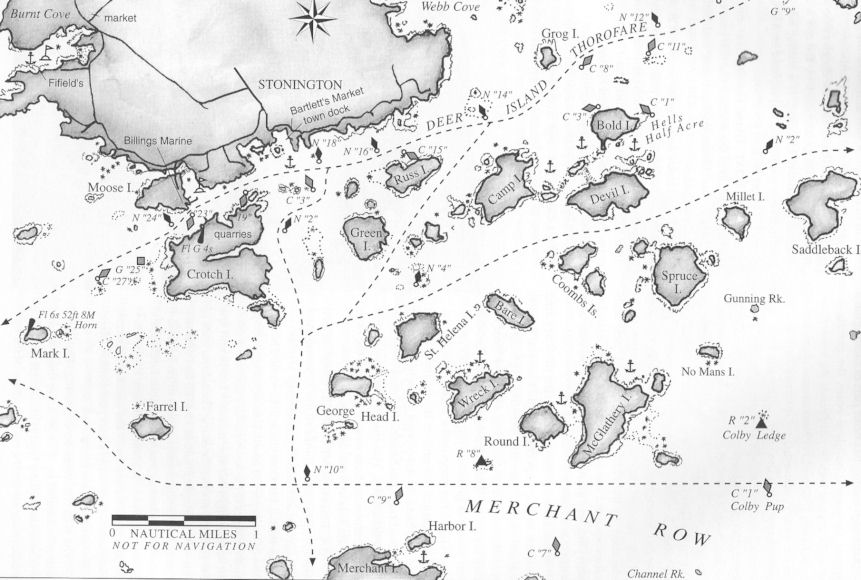 click here for larger version of chart Departing
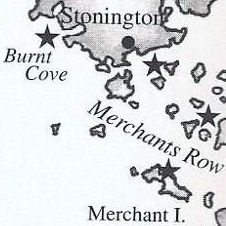 Scattered throughout Merchants Row,
there are many terrific anchorages I’ve enjoyed over the years.
By now though, it is getting into the afternoon. So I decide the well
protected harbor at Merchant Island, though popular and
frequented by bigger boats, is the best choice for the night. It
is the closest and most direct destination from Vinalhaven.
Approaching Merchant Island, we can see that the incoming tide has already covered the harbor bar. This poses an irresistible temptation to tweak some noses on a couple of big yachts already anchored inside. “Forget rounding the island,” I say to Dennis, while lifting the centerboard part way. “Let’s cut across the bar!” Running full tilt we arrive, round up sharply, luff the sails, and dropped the big Bruce anchor precisely where we want it. Venturing a glance at the rich-man yachts across the way, I inwardly puff my chest - “can you guys do that?!” Even having made two stops, our day’s distance made good is approximately 15 NM. Tonight was Dennis’ turn to cook. He made a delicious dinner of huge proportions—Indian Corn Stew. It entailed quite a few cans of stuff, but only one pot. Dennis likes to cook and has a number of great camping recipes. He’s a great guy to have as a shipmate, in all respects. Again the night is sparkling clear, the stars are spectacular and soon joined by an oversize moon approaching full. Tides will exceed 10 feet the next couple of days.
|
||
|
Tuesday,
Sep. 1.
Greeting us is
brilliant sunshine and a
cloudless sky; this promises to be a light-air day - unusual for
Maine - but so is such phenomenal weather!
Following the necessary morning landing on
Setting
expectations low, I decide to
aim for
Burnt Coat Harbor on Swans Island—a distance of about 10 NM to the
east. Should
the afternoon southwesterly decide to kick in we can reevaluate.
Meanwhile, judging from our progress relative
to the lobster trap buoys, Blue
Mist is
getting a pretty decent push from the
tide. This surprises me. Though the tide is falling, we are
being
carried eastward. According to Taft, with
an ebbing tide we would expect the current to run westerly; the tide
should
have been foul! Though still a mystery
to me, the half knot or so of free ride was a
significant benefit.
Burnt Coat Harbor is another of my
favorite places. I’ve sailed into it a number of times. A fascinating
lobstermen’s harbor, it is also beautiful and picturesque; and being
far from the mainland, it hasn’t changed much during the period of time
I’ve known it.
I confess. I love a chance to show off. Making a smart landing, under full sail into a tight spot, on the lobster Co-op’s float was one of those times. It isn’t without risk, but showing some clever boat handling has never hurt. Few lobstermen know a lot about sailing, and, as a rule, they’re all business with no time for chitchat; but you can tell they respect good boat handling and seamanship. Just watch how they like jockeying their boats around in close quarters. They are not the least timid and relish ‘gunning’ the engine! 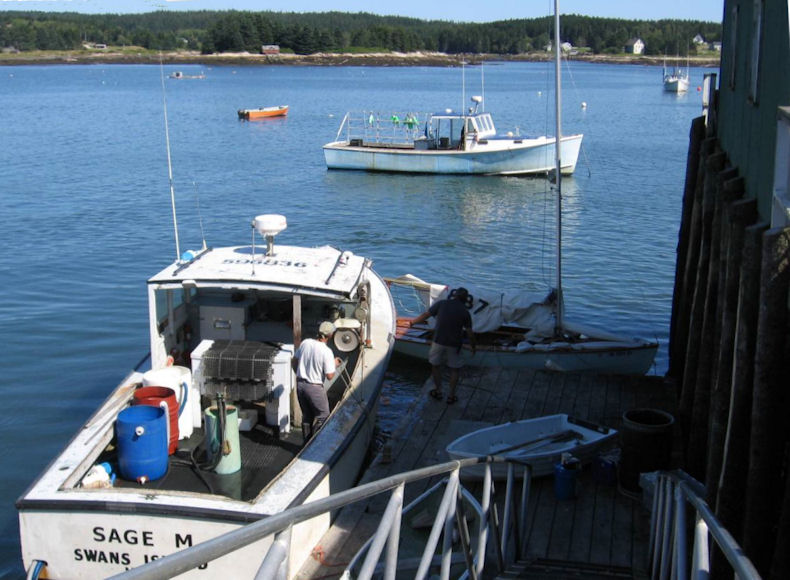 A tight landing spot at the Lobster Co-op. As a dinghy sailor
I’ve always been
treated with respect by lobstermen. Many times I’ve been allowed
to tie up for
the night at a ‘spare’ mooring. “Yachtsmen”
don’t typically get that kind of
consideration.
Space is always limited, so when landing at a lobster pound or Co-op I’m very careful to choose an out-of-way spot. Then I quickly introduce myself and make sure it’s okay to stay where I am. For a dinghy cruiser, landing at a lobster pound or Co-op means an opportunity to use their port-a-potty, as well as stretch one’s legs ashore. When we arrived in the early afternoon, the Co-op was bustling. Boats were just beginning to bring in their catch. Dock hands were busy sorting, weighing, and recording lobsters, then transferring them to temporary holding pens. One after another, a steady line of lobstermen came in. Following unloading, as needed, some boats moved to the fueling station, or took on barrels of fresh bait. An awful lot of lobsters were coming off the boats and it occurred to me that we must have arrived at a peak fishing period. Of course, I was also informed that the price had just gone up. Most of what I know about lobster
fishing comes from observations I’ve made while cruising. I’m not
an expert. Nevertheless, I rarely tire of watching the activity
at a lobster pound. These days, it seems that most lobster
pounds are Co-ops, which are owned and operated by the lobstermen
themselves. Independent lobster pounds that buy directly from the
lobstermen appear to be on the decline. Co-ops are able to
exercise more control over market price by such means as holding back
the catch, and can manage costs more effectively. In other words,
the middleman has been eliminated.
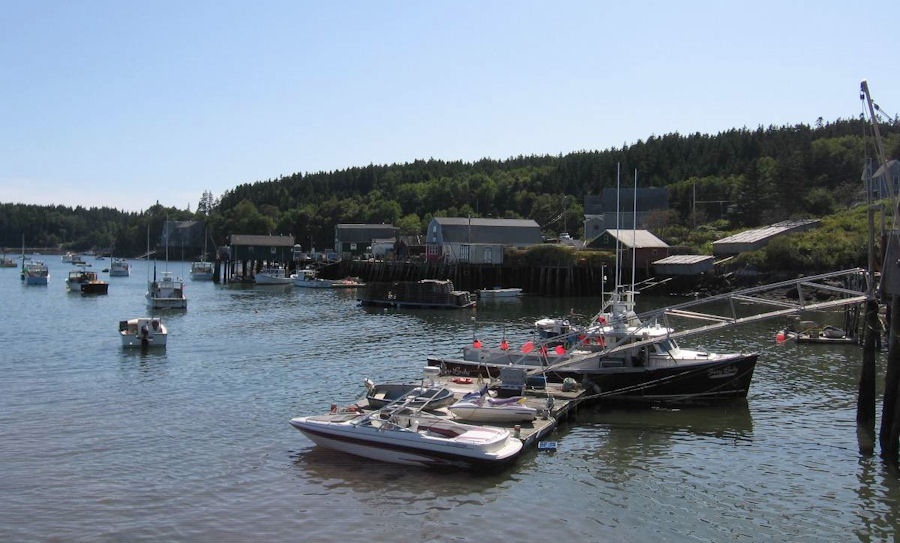 View of the lobster industry Fresh lobsters are
shipped out by refrigerated truck, while diesel fuel and trailer loads
of smelly frozen bait fish are brought in. It is the bait fish that
makes a lobster pound stink so badly. At Swans Island
everything ultimately comes or goes by ferry from the mainland. When
locals want lobsters, they go to the nearest lobster pound.
However, you have to get there in the afternoon. Lobstermen start their
day around 5:00 AM and the Co-op is usually closed by 4:00 PM. I’ve
learned that the hard way. Also learned the hard way, there’s little
chance of getting any sleep in the early morning hours when anchored
around lobster boats.
The woman managing the Co-op dock tells me she’ll be working late; so we’ll be okay waiting till four to pick up lobsters. That gives Dennis and me a couple of hours to take a walk around the harbor, and then go for a short sail to figure out where to anchor for the night. We don’t want to be amongst the lobster boats. Taken by the beauty of the harbor, I shoot lots of pictures. Buying the lobster results in some confusion—the lingo, it seems, has changed some from the past. They don’t have any ‘hard-shell’, just the soft, ‘new-shell’. “That’s okay,” I say. But having less meat in the shell means I want to go bigger—like around 2-pounders. Her face is blank—“You want jumbos?” she says. Hesitating for half a second, I say, “Yah, let’s do that.” - not knowing exactly what I’ve agreed to. In the end everything works out fine. I walk away lighter in the wallet, but with two monster, possibly 2-1/2 pound, lobsters. Yes, she weighed them! As soon as the anchor is set, I take the lobsters from the bucket, place them in a net bag and dump them over the side. Lobsters need to be cooked live and they will not survive long in a bucket. 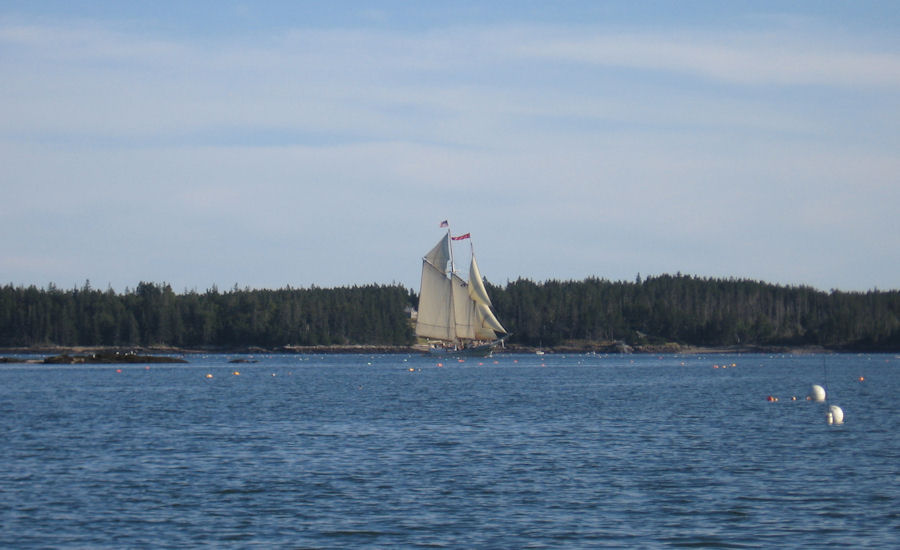 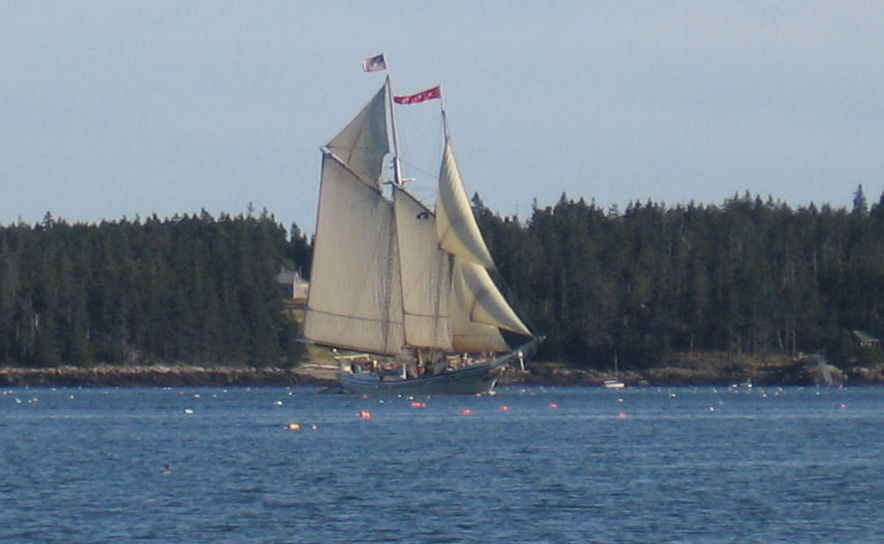 Heritage arriving under full sail Relaxing with a beer
before dinner, we are treated to the sight of a majestic windjammer
sailing in under full canvass. She is flying all her topsails and
strikes a marvelous pose. Along the way, we’ve been sighting
various members of Maine’s windjammer fleet, but they have always been
off in the distance. Later, we learned this schooner is the Heritage. We enjoyed having
her company.
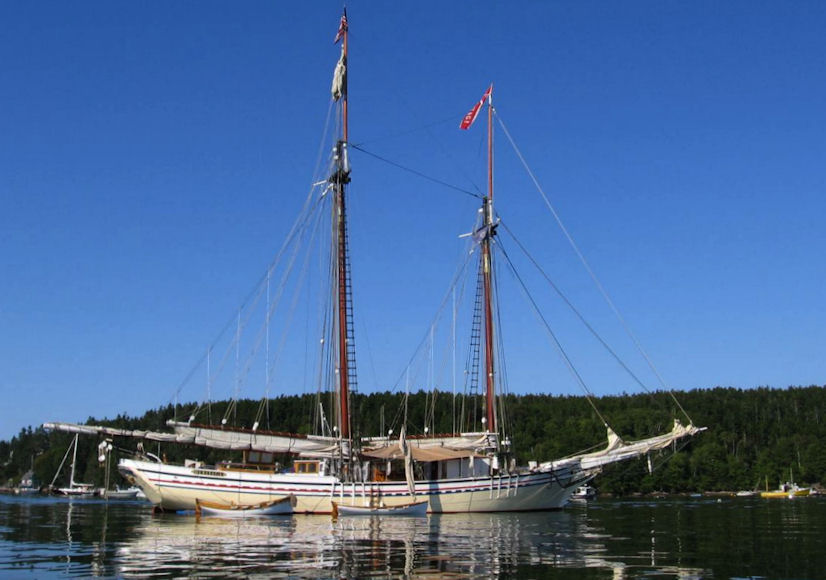 Heritage the following morning The Heritage
has with her a long boat, that is sprit-sail rigged, as well as what
appears to
be a push boat. It may be she doesn’t
have a working engine - we don’t know. It isn’t long
before the long boat is put out,
filled with cruise passengers. There is
a lot of laughter and shouting, they are having a ball sailing the much
smaller
vessel. We wonder, “Is this the highlight of the
day?”
Toward dusk the sweet melodic sound of
bagpipes drifts across to us. Too soon,
however, the concert ends.
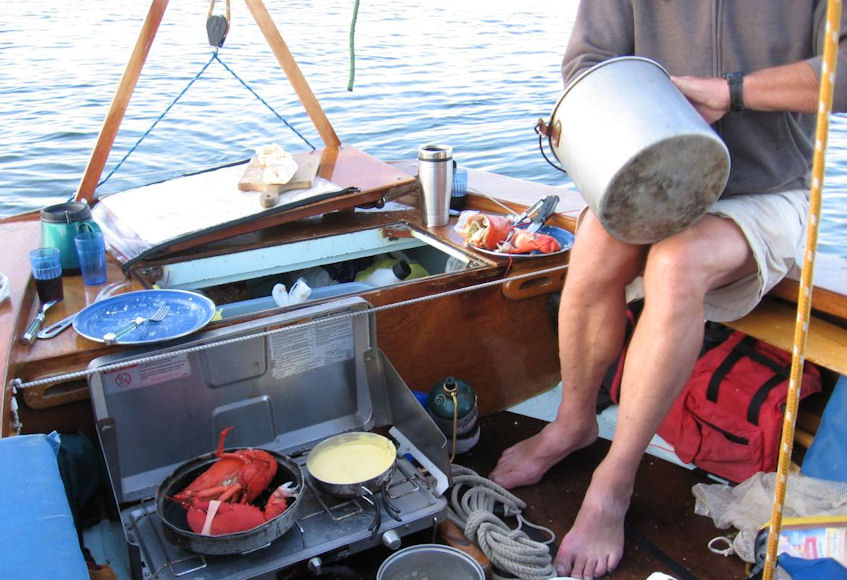 Feasting on When dinghy
cruising where tides are
small or don’t exist, it
is often possible to go ashore to prepare
meals. On the coast of Maine this isn’t practical: all cooking is
done on board. The photo
above
shows
how it’s done. The stove stows inside the
aft
compartment. Blue Mist’s
aft side benches were removed years ago, making the
cockpit roomier. Not apparent in the
picture, the boom tent is already over the forward part of the cockpit,
creating
a windbreak. For a small vessel, this
arrangement
works remarkably well.
End of Part I
|
||
|
Coming up in Part II: Frenchboro—‘stepping back in time’; Buckle Harbor—‘mussels galore’; Eggemoggin Reach—‘meeting up with Chris and Jennifer, sailing W2414’; ‘the Barred Islands’; ‘North Haven Island’; High Island—‘one rough night!’ |
| next
page return to index page |
